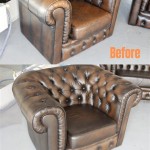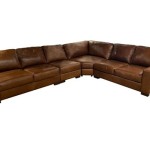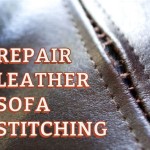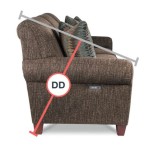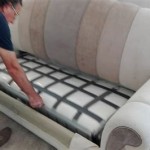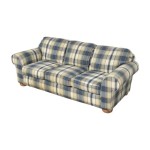Fix a Leather Sofa
Leather sofas represent a significant investment, prized for their durability and aesthetic appeal. Over time, however, even the highest quality leather can succumb to wear and tear, requiring repairs to maintain its appearance and functionality. Addressing these issues promptly can prevent further damage and extend the lifespan of the sofa.
Common leather sofa problems include scratches, cracks, tears, stains, and fading. The appropriate repair method depends on the type and severity of the damage, as well as the type of leather. Aniline leather, for instance, is more susceptible to scratches and stains than pigmented or protected leather.
Scratches: Superficial scratches on protected or pigmented leather can often be remedied with a leather conditioner. Apply the conditioner according to the manufacturer's instructions, typically using a soft cloth and circular motions. Deeper scratches may require a leather filler product, carefully matched to the sofa's color. After application, allow the filler to dry completely and then buff the area with a soft cloth.
Cracks: Cracks in leather are often a result of dryness and require a more intensive approach. Start by cleaning the affected area with a leather cleaner. Then, apply a leather conditioner to moisturize the leather and help it regain some of its flexibility. For larger cracks, a leather repair compound may be necessary. These compounds fill the cracks and create a more uniform surface. Follow the manufacturer's instructions for application and drying times.
Tears: Small tears can sometimes be repaired using a leather adhesive. Clean the area around the tear and carefully align the edges before applying the adhesive. Larger tears, however, may require patching. Leather patching involves placing a piece of leather underneath the tear and adhering it with a strong adhesive. This repair is best left to professional upholsterers for optimal results.
Stains: Stains on leather sofas should be addressed promptly to prevent them from setting. Different types of stains require different cleaning methods. Water-based stains can often be removed with a damp cloth. For oil-based stains, sprinkle baking soda onto the affected area to absorb the oil, then vacuum it up after a few hours. Ink stains can sometimes be removed with rubbing alcohol, but it is crucial to test this in an inconspicuous area first. For stubborn or complex stains, professional leather cleaning services are recommended.
Fading: Fading is often caused by prolonged exposure to sunlight. Preventing fading is the best approach, which can be achieved by positioning the sofa away from direct sunlight or using window coverings. Once fading has occurred, restoring the original color is difficult. Leather recoloring products are available, but they require careful application and color matching to achieve satisfactory results. Consulting a professional leather restoration service is advisable for significant fading issues.
Regular maintenance is essential for preventing damage and extending the life of a leather sofa. This includes routine cleaning and conditioning. Dust the sofa regularly using a soft cloth or vacuum cleaner with a soft brush attachment. Condition the leather every six to twelve months to keep it moisturized and prevent cracking. Avoid using harsh chemicals or abrasive cleaners, as these can damage the leather.
Choosing the correct cleaning and repair products is crucial. Always test any new product in an inconspicuous area first to ensure it does not damage the leather or alter its color. When in doubt, consulting a professional leather repair specialist is recommended. They possess the expertise and specialized tools to handle complex repairs and restorations effectively.
Understanding the type of leather on the sofa is crucial for selecting the appropriate cleaning and repair methods. Different types of leather have different properties and require specific care. If unsure about the leather type, consult the manufacturer or a furniture professional.
Protecting the leather sofa from further damage is important after repairs are completed. Consider using leather protectants to shield the sofa from spills and stains. These products create a barrier that repels liquids and makes cleaning easier. Additionally, placing coasters under drinks and avoiding contact with sharp objects can help prevent future damage.
Repairing a leather sofa can be a challenging task, especially for significant damage like tears or deep cracks. While some minor repairs can be accomplished with readily available products and some DIY skills, complex repairs often require the expertise of a professional upholsterer or leather repair specialist. Their knowledge and experience can ensure a high-quality repair that restores the sofa's appearance and functionality.
Proper care and timely repairs can significantly extend the lifespan of a leather sofa, preserving its beauty and ensuring continued enjoyment for years to come. Understanding the different types of damage, appropriate repair methods, and preventative measures allows owners to maintain their leather furniture in optimal condition.

Leather Furniture Repair Couch Chair Restoration

What Is Involved In A Leather Couch Repair We Can Fix That

Leather Furniture Repair Couch Chair Restoration

Fix A Rip In Your Leather Sofa Design Inkarnation Art And The Human Condition

Our Leather Repair Dyes Used On This Old Faded Worn Couch

Best Leather Dye For Couches Colors Restoration Supplies

Repairing Torn Leather A Quick And Dirty Guide Drsofa Com Blog

How To Fix Bonded Leather Ling Von Baer

Fix Faded Leather Fast

Leather Sofa Restoration How To Re Faded

